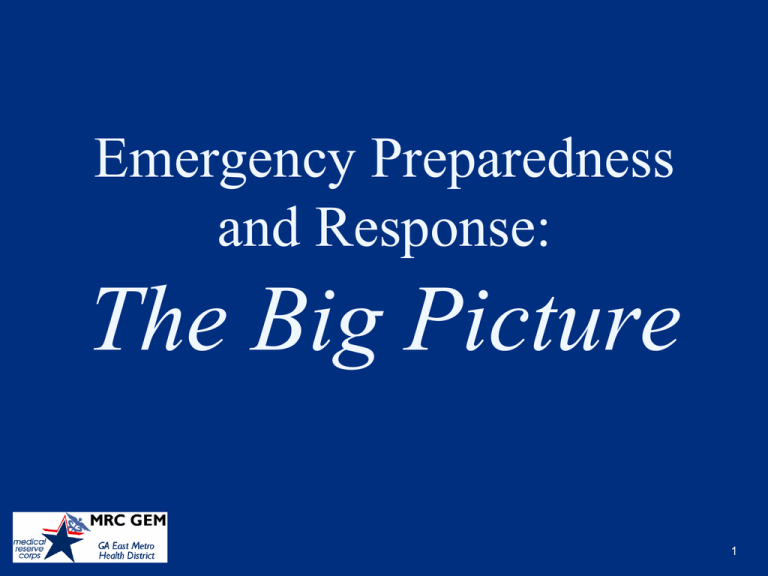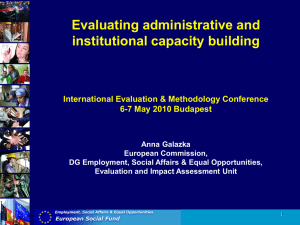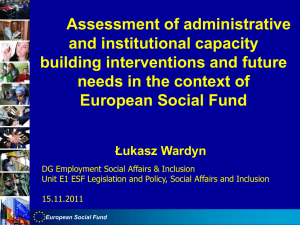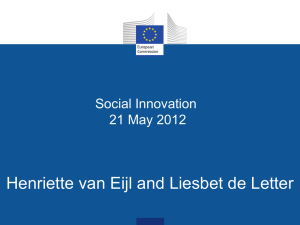Presentation title slide - 42 pt Times New Roman, White
advertisement

Emergency Preparedness and Response: The Big Picture 1 The National Response Framework Core Document Doctrine, organization, roles and responsibilities, response actions and planning requirements that guide national response Emergency Support Function Annexes Mechanisms to group and provide Federal resources and capabilities to support State and local responders Support Annexes Essential supporting aspects of the Federal response common to all incidents Incident Annexes Incident-specific applications of the Framework Partner Guides Next level of detail in response actions tailored to the actionable entity www.fema.gov/nrf 2 Applying the Framework Most incidents managed entirely locally: Some require additional support Small number require Federal support Catastrophic requires significant Federal support State Governor must request Federal support Minor event might just be start of larger threat: Could rapidly grow larger Need to accelerate assessment and response Federal Department/Agency acting on own authority may be initial Federal responder Integrated, systematic Federal response intended to occur seamlessly 3 Effective, unified national response requires layered, mutually-supporting capabilities Local officials have primary responsibility for community preparedness and response and are responsible for ensuring the public safety and welfare of their jurisdiction. The local emergency manager has the day-to-day authority and responsibility for overseeing emergency management programs and activities. State & Tribal Governments Local Governments NRF Federal Government Private Sector & NGO 4 Effective, unified national response requires layered, mutually-supporting capabilities States are sovereign entities. The Governor is responsible for public safety and welfare. States are the main players in coordinating resources and capabilities and obtaining support from other States and the Federal government. A primary role of State government is to supplement and facilitate local efforts before, during, and after incidents. Governors, State homeland security advisors, State emergency management directors, and tribal leaders have key roles and responsibilities in incident management. State & Tribal Governments Local Governments NRF Federal Government Private Sector & NGO 5 Effective, unified national response requires layered, mutually-supporting capabilities The Private Sector supports community response, organizes business to ensure resiliency, and protects and restores critical infrastructure and commercial activity. • Government works with private sector groups as partners in emergency management. Major portions of the nation’s critical infrastructure are operated and maintained by the private sector. State & Tribal Governments Local Governments NRF Federal Government Private Sector & NGO 6 Effective, unified national response requires layered, mutually-supporting capabilities NGOs (non-governmental organizations): Assist individuals who have special needs Coordinate volunteers Interface with government response officials at all levels Perform other vital missions For example, NGOs provide sheltering, emergency food supplies, counseling, and other vital services to support response and promote the recovery of disaster victims. State & Tribal Governments Local Governments NRF Federal Government Private Sector & NGO 7 Effective, unified national response requires layered, mutually-supporting capabilities Individuals and Households are key starting points for emergency preparedness and support community efforts. Though not formally part of emergency operations, they play a key role in the overall emergency management strategy. They can contribute by reducing hazards in and around their homes, preparing emergency supply kits and household emergency plans, and carefully monitoring emergency communications. State & Tribal Governments Local Governments NRF Federal Government Private Sector & NGO 8 Emergency Support Functions / Annexes • • • • • • • • • • • • • • • ESF #1 - Transportation ESF #2 - Communications ESF #3 - Public Works and Engineering ESF #4 - Firefighting ESF #5 - Emergency Management ESF #6 - Mass Care, Emergency Assistance, Housing and Human Services ESF #7 - Logistics Management and Resource Support ESF #8 - Public Health and Medical Services ESF #9 - Search and Rescue ESF #10 - Oil and Hazardous Materials Response ESF #11 - Agriculture and Natural Resources ESF #12 - Energy ESF #13 - Public Safety and Security ESF #14 - Long-Term Community Recovery ESF #15 - External Affairs 9 Emergency Support Functions / Annexes • • • • • • • • • • • • • • • ESF #1 - Transportation ESF #2 - Communications ESF #3 - Public Works and Engineering ESF #4 - Firefighting ESF #5 - Emergency Management ESF #6 - Mass Care, Emergency Assistance, Housing and Human Services ESF #7 - Logistics Management and Resource Support ESF #8 - Public Health and Medical Services ESF #9 - Search and Rescue ESF #10 - Oil and Hazardous Materials Response ESF #11 - Agriculture and Natural Resources ESF #12 - Energy ESF #13 - Public Safety and Security ESF #14 - Long-Term Community Recovery ESF #15 - External Affairs 10 ESF #6 in Gwinnett County The Department of Human Resources (DHR) Division of Family and Children Services (DFCS) has primary government agency responsibility. The American Red Cross (ARC) has primary volunteer organization responsibility. Supporting roles: East Metro Health District (EMHD) - Personnel, environmental inspections Georgia Baptist Convention - Child care, food, personnel The Salvation Army - Donated goods, food Local Law Enforcement - Security Local Departments of Education and others - Facilities 11 Note roles of entities State: Dept. of Human Resources (DHR) Div. of Family and Children Services (DFCS) NGO: American Red Cross (ARC), Georgia Baptist Convention, The Salvation Army State and Local Gov: East Metro Health District (EMHD) Local Gov: Law Enforcement, Department of Education Private Sector: Businesses assisting in other ways Re NGOs: American Red Cross, GA Baptist Convention, Salvation Army, American Radio Relay League, many others are members of National and/or Georgia Voluntary Organizations Active in Disaster (VOAD). 12 Emergency Support Functions / Annexes • • • • • • • • • • • • • • • ESF #1 - Transportation ESF #2 - Communications ESF #3 - Public Works and Engineering ESF #4 - Firefighting ESF #5 - Emergency Management ESF #6 - Mass Care, Emergency Assistance, Housing and Human Services ESF #7 - Logistics Management and Resource Support ESF #8 - Public Health and Medical Services ESF #9 - Search and Rescue ESF #10 - Oil and Hazardous Materials Response ESF #11 - Agriculture and Natural Resources ESF #12 - Energy ESF #13 - Public Safety and Security ESF #14 - Long-Term Community Recovery ESF #15 - External Affairs 13 ESF #8 in Gwinnett County Under ESF #8, Public Health: Coordinates and/or delivers medical, environmental health, and mental health services Accesses and/or seeks health-related private resources Supplements disrupted or overburdened health service delivery personnel and resources Coordinates rehabilitation support 14 Support Annexes • Critical Infrastructure and Key Resources • Financial Management • International Coordination • Private Sector Coordination • Public Affairs • Tribal Relations • Volunteer and Donations Management • Worker Safety and Health Incident Annexes • • • • • • • Biological Incident Catastrophic Incident Cyber Incident Food and Agriculture Incident Mass Evacuation Incident Nuclear/Radiological Incident Terrorism Incident Law Enforcement and Investigation 15 Support Annex A14 Volunteer Programs Management Addresses how the Medical Reserve Corps program integrates with emergency response Describes where volunteers might be used in a healthcare emergency Provides forms that must be completed to address liability issues Provides job action sheets that can be used for just-in-time training Support Annex A15 Modular Emergency Medical System Addresses medical surge options in support of hospitals Defines Neighborhood Emergency Help Center Defines Acute Care Center Defines staffing requirements based on given configuration Does not address specific alternative standards of care protocols Support Annex A16 Strategic National Stockpile Criteria for and how to request the SNS Mass dispensing/vaccination procedures Manpower requirements Just-in-time training materials for using volunteers Medication control procedures Patient education What is the Strategic National Stockpile ? A large CDC-managed stockpile of medicine and medical supplies to protect the American public if there is a public health emergency severe enough to cause local supplies to run out. You can learn more about the Strategic National Stockpile at http://www.bt.cdc.gov/stockpile Strategic National Stockpile Components Push Pack/12 Hours Vendor Managed Inventory/ 24-36 hours SNS Responsibilities SNS Send medications / vaccines Provide technical assistance State and Local governments Demonstrate need for supplies Receive, stage and store supplies Dispense at community PODs Hospitals Dispense to at hospital PODs What is a POD? Point of dispensing (POD) - a place where a vaccine, antibiotic or other medication is dispensed quickly to a large group of people. First Responders Hospital staff & patients Community members Why would a POD be activated? Usually: To prevent disease in those exposed to an infection but who are not yet sick Possibly: To treat an infectious disease The treatment offered would be limited to dispensing a specific medication. What Kinds of Emergencies Might Require a POD? Natural disaster Influenza pandemic Bioterrorism attack









